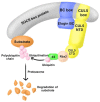The functions and properties of cullin-5, a potential therapeutic target for cancers
- PMID: 32194910
- PMCID: PMC7061844
The functions and properties of cullin-5, a potential therapeutic target for cancers
Abstract
Cullin-5 (CUL5), a scaffold protein in active cullin-RING ubiquitin ligase (CRL) complexes, is a member of the cullin family of proteins. The CUL5-type ubiquitin ligase can target multiple proteins involved in ubiquitination and proteasome degradation. CUL5 plays positive roles in regulating cell growth, proliferation and physiological and other processes in the human body. It has been found that the expression of CUL5 is significantly downregulated in various cancer cells, which affects the course of the cancers. Here, we reviewed the current data on the expression and role of CUL5 in both normal and cancer cells, its possible mechanisms, and its potential as a therapeutic target for cancers.
Keywords: Cullin-5; cancer; microRNAs; regulation; therapeutics; ubiquitin.
AJTR Copyright © 2020.
Conflict of interest statement
None.
Figures



Similar articles
-
Cullin-5, a ubiquitin ligase scaffold protein, is significantly underexpressed in endometrial adenocarcinomas and is a target of miR-182.Oncol Rep. 2016 Apr;35(4):2461-5. doi: 10.3892/or.2016.4605. Epub 2016 Feb 1. Oncol Rep. 2016. PMID: 26847831 Free PMC article.
-
The role of cullin 5-containing ubiquitin ligases.Cell Div. 2016 Mar 9;11:1. doi: 10.1186/s13008-016-0016-3. eCollection 2016. Cell Div. 2016. PMID: 27030794 Free PMC article. Review.
-
Primate lentiviral virion infectivity factors are substrate receptors that assemble with cullin 5-E3 ligase through a HCCH motif to suppress APOBEC3G.Proc Natl Acad Sci U S A. 2005 Aug 9;102(32):11444-9. doi: 10.1073/pnas.0502440102. Epub 2005 Aug 2. Proc Natl Acad Sci U S A. 2005. PMID: 16076960 Free PMC article.
-
Rotavirus NSP1 Associates with Components of the Cullin RING Ligase Family of E3 Ubiquitin Ligases.J Virol. 2016 Jun 10;90(13):6036-48. doi: 10.1128/JVI.00704-16. Print 2016 Jul 1. J Virol. 2016. PMID: 27099313 Free PMC article.
-
Deregulation of the COP9 signalosome-cullin-RING ubiquitin-ligase pathway: mechanisms and roles in urological cancers.Int J Biochem Cell Biol. 2013 Jul;45(7):1327-37. doi: 10.1016/j.biocel.2013.03.023. Epub 2013 Apr 10. Int J Biochem Cell Biol. 2013. PMID: 23583660 Review.
Cited by
-
Cul5 mediates taurine-stimulated mTOR mRNA expression and proliferation of mouse mammary epithelial cells.Amino Acids. 2023 Feb;55(2):243-252. doi: 10.1007/s00726-022-03222-9. Epub 2022 Nov 30. Amino Acids. 2023. PMID: 36449095
-
CRISPR screens in iPSC-derived neurons reveal principles of tau proteostasis.bioRxiv [Preprint]. 2024 Nov 4:2023.06.16.545386. doi: 10.1101/2023.06.16.545386. bioRxiv. 2024. PMID: 37398204 Free PMC article. Preprint.
-
Cullin-5 (CUL5) as a potential prognostic marker in a pan-cancer analysis of human tumors.Bioengineered. 2021 Dec;12(1):5348-5360. doi: 10.1080/21655979.2021.1940042. Bioengineered. 2021. PMID: 34415831 Free PMC article.
-
Cullin3 (CUL3) suppresses proliferation, migration and phenotypic transformation of PDGF-BB-stimulated vascular smooth muscle cells and mitigates inflammatory response by repressing Hedgehog signaling pathway.Bioengineered. 2021 Dec;12(2):9463-9472. doi: 10.1080/21655979.2021.1995572. Bioengineered. 2021. PMID: 34699319 Free PMC article.
-
Analysis of cullin family genes in rectal adenocarcinoma: expression, prognostic significance, and therapeutic implications.Am J Transl Res. 2025 May 15;17(5):3842-3861. doi: 10.62347/UNVS8140. eCollection 2025. Am J Transl Res. 2025. PMID: 40535676 Free PMC article.
References
-
- Lamsoul I, Uttenweiler-Joseph S, Moog-Lutz C, Lutz PG. Cullin 5-RING E3 ubiquitin ligases, new therapeutic targets? Biochimie. 2016;122:339–347. - PubMed
-
- Li Q, Cui M, Yang F, Li N, Jiang B, Yu Z, Zhang D, Wang Y, Zhu X, Hu H, Li PS, Ning SL, Wang S, Qi H, Song H, He D, Lin A, Zhang J, Liu F, Zhao J, Gao L, Yi F, Xue T, Sun JP, Gong Y, Yu X. A cullin 4B-RING E3 ligase complex fine-tunes pancreatic delta cell paracrine interactions. J Clin Invest. 2017;127:2631–2646. - PMC - PubMed
-
- Burnatowska-Hledin MA, Spielman WS, Smith WL, Shi P, Meyer JM, Dewitt DL. Expression cloning of an AVP-activated, calcium-mobilizing receptor from rabbit kidney medulla. Am J Physiol. 1995;268:F1198–1210. - PubMed
Publication types
LinkOut - more resources
Full Text Sources
Other Literature Sources
